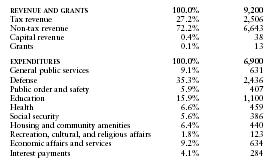Oman - Public finance
Although Oman is a relatively small oil producer, oil revenues support 69% of government expenditures. The government owns 60% of Petroleum Development (Oman) Ltd. (PDO), the main oil company. Higher oil prices in 1997 and a 5% cut in capital spending produced a budget deficit of only $47 million, a substantial improvement over 1996. With the fall in global oil prices in 1998, however, the government's budget fell deeply into deficit, and had to be financed by loans and by drawing down the State General Reserve Fund. In anticipation of still further drops in the price of oil, the government increased a number of taxes and imposed spending cuts of between 5 and 10% on most government ministries.
The US Central Intelligence Agency (CIA) estimates that in 2000 Oman's central government took in revenues of approximately $9.2 billion and had expenditures of $6.9 billion. Overall, the government registered a surplus of approximately $2.3 billion. External debt totaled $5.3 billion.
The following table shows an itemized breakdown of government revenues and expenditures. The percentages were calculated from data reported by the International Monetary Fund. The dollar amounts (millions) are based on the CIA estimates provided above.

| REVENUE AND GRANTS | 100.0% | 9,200 |
| Tax revenue | 27.2% | 2,506 |
| Non-tax revenue | 72.2% | 6,643 |
| Capital revenue | 0.4% | 38 |
| Grants | 0.1% | 13 |
| EXPENDITURES | 100.0% | 6,900 |
| General public services | 9.1% | 631 |
| Defense | 35.3% | 2,436 |
| Public order and safety | 5.9% | 407 |
| Education | 15.9% | 1,100 |
| Health | 6.6% | 459 |
| Social security | 5.6% | 386 |
| Housing and community amenities | 6.4% | 440 |
| Recreation, cultural, and religious affairs | 1.8% | 123 |
| Economic affairs and services | 9.2% | 634 |
| Interest payments | 4.1% | 284 |
Comment about this article, ask questions, or add new information about this topic: